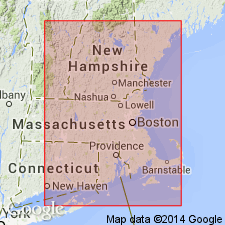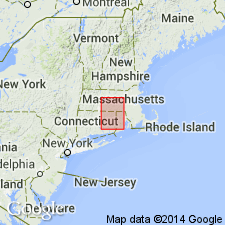
- Usage in publication:
-
- Dudley Formation*
- Modifications:
-
- Named
- Dominant lithology:
-
- Schist
- AAPG geologic province:
-
- New England province
Summary:
The Dudley Formation, here named for the town of Dudley, Worcester Co., MA, is the lower unit of the revised Paxton Group in northeastern CT and central MA. It consists of fine-grained, thin-bedded schistose granulite and calc-silicate-bearing beds typical of the Paxton. It gradationally and conformably overlies the Oakdale Formation and gradationally and conformably underlies the Southbridge Formation of the Paxton. Maximum thickness is 1,000 m (3,280 ft) at the type section. Age is Late Proterozoic.
Source: GNU records (USGS DDS-6; Reston GNULEX).

- Usage in publication:
-
- Dudley Formation*
- Modifications:
-
- Revised
- Geochronologic dating
- AAPG geologic province:
-
- New England province
Summary:
The Dudley Formation at the base of the Paxton Group includes strata formerly mapped as Hebron Formation in CT and as Paxton Formation in MA and is transitional from the Oakdale to the overlying Southbridge Formation. A kyanite schist member of the Dudley, mapped as Scotland Schist by Dixon and Lundgren (1968), is recognized in the Spring Hill and Hampton quads., CT. It overlies and underlies granofels and granular schist and has a maximum thickness of 250 m. Age of the Dudley is Late Proterozoic(?) based on the intrusion of 440 m.y. Hedgehog Hill gneiss in the overlying Brimfield Group and an age of 1188 m.y. for detrital zircons from the Paxton.
Source: GNU records (USGS DDS-6; Reston GNULEX).
For more information, please contact Nancy Stamm, Geologic Names Committee Secretary.
Asterisk (*) indicates published by U.S. Geological Survey authors.
"No current usage" (†) implies that a name has been abandoned or has fallen into disuse. Former usage and, if known, replacement name given in parentheses ( ).
Slash (/) indicates name conflicts with nomenclatural guidelines (CSN, 1933; ACSN, 1961, 1970; NACSN, 1983, 2005, 2021). May be explained within brackets ([ ]).

